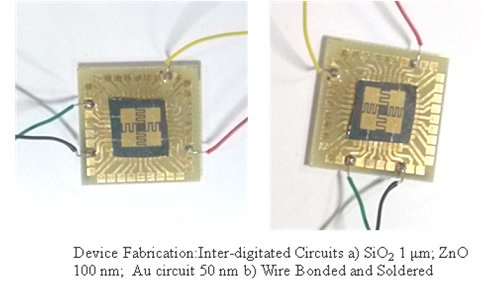The ICAR-National Bureau of Agricultural Insect Resources, Bengaluru in collaboration with the Indian Institute of Science, Bengaluru initiated a new Artificial Intelligence (AI) envisioned research for helping the farmers in managing the pests.
As a model insect, the Institute developed a Sensor for Bactrocera oleae (Rossi). The major hindrances in achieving the large scale production of the olive oil, preferred oil worldwide over the other vegetable oils is due to fruit pests which cause serious damage to olive orchards. Their control requires careful monitoring and the timely application of suitable remedies before substantial pest infestation. The Institute demonstrated the efficacious utilization of covalently functionalized β-cyclodextrinylated Micro-Electromechanical System (MEMS) devices for the selective and sensitive detection of the female sex pheromone of the olive fruit fly, Bactrocera oleae.

The two of the MEMS devices, silicon dioxide surface-micro machined cantilever arrays and zinc oxide surface-micro fabricated interdigitated circuits, selectively capture the major pheromone component, 1, 7-dioxaspiro [5, 5] undecane. The non-covalent capture of olive pheromones inside the β-cyclodextrin cavity reduces the resonant frequency of the cantilevers, whereas, an increase in resistance has been found in case of zinc oxide derived MEMS devices. The devices’ sensitivity towards the olive pheromone was found to be directly correlated with the increasing availability of β-cyclodextrin moieties over the surface of the devices. Thus, the detection limit of the devices has been achieved to a value as low as 0.297 ppq of the olive pheromone when the devices were functionalized with one of the standardized protocols.
Before the onset of substantial pest infestation in an orchard makes the technology quite attractive for viable commercial application. In a way, the technology can be considered a step forward in Artificial Intelligence (AI) as it is dependent on sensors and feedback loops as originally described by Norbert Weiner who foresaw many future developments in the general field. The theoretical implication of the work fits into a revolution into agri-technology that will revolutionize the food production worldwide.
(Source: ICAR-National Bureau of Agricultural Insect Resources, Bengaluru)







फेसबुक पर लाइक करें
यूट्यूब पर सदस्यता लें
X पर फॉलो करना X
इंस्टाग्राम पर लाइक करें